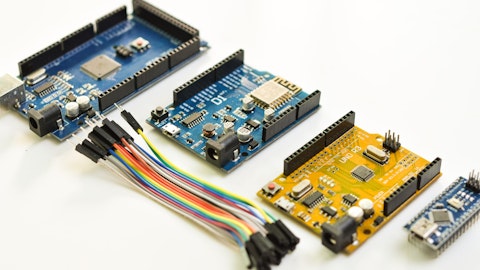Q – Matt Ramsay: That note — thank you by the way I appreciate all the color. That was really helpful. I guess is my next question. Sandeep, a couple of things. One, you talked a little bit about in your script how you are seeing channel inventory levels and order patterns. I might wonder if you might comment a bit about customer level inventories that to the extent that you have visibility — has that visibility improve any as you work through some of the challenges in the channel with the customer base. And I guess the second question totally unrelated on gross margin, you said 54 for the year. I guess, if you could help with the puts and takes there and what kind of assumptions you have on the yen and that 54 number that would be helpful? Thank you.
Sandeep Nayyar: Yeah, I think definitely especially in the consumer space segment, you’ve seen chat in the not only the channel but even customer inventory. As you remember in the past we talked about our major customers in Korea. We hadn’t taken for a long time and we are starting to see orders there. So clearly you’re seeing a movement and the channel inventory in consumer is well-below what I call a normal average, but industrial is still a bit higher. So that we know will work out. But I think definitely if you really look at or it’s playing out as we expected. As far as the gross margin, it’s basically as you will see is you’re going to see the yen is going to be favorable, the volume increase for the back-end utilization is better as we go out.
Obviously the mix will go a bit unfavorable as the quarter progressed, as year progresses as communication starts coming back. But if you want to look at the whole year it is really everything mix yen and basically the utilization. But the input costs as the headwind and even for next year, I think that’s going to be the case where again continues, now in Q1 the yen was actually a little bit down. The reason being if you remember last year, the yen had moved down to about 130 level for a period of time. And it takes a while for it to flow in the P&L. But as you can see, the yen has strengthened and I mean the dollar has strengthened and as a result with the inventory accounting, I think that benefit will even flow quite a bit into next year.
So I kind of feel that even for next year, we will stay at a higher level even though input costs maybe, or headwind but we’ll remain if you look at our model on the higher end of our model.
Operator: Thank you. Your next question comes from the line of Tore Svanberg from Stifel. Please go ahead.
Unidentified Analyst: Yes, good afternoon. This is Jeremy [ph] calling for Tore. Just a two things here. Maybe if we could just circle back on the InnoMux-2. It looks like a really fantastic product here. I was wondering in terms of the DC-to-DC power conversion, it seems like you’ve had to develop some expertise there, is there — are there other areas where you want to take this where it’s maybe more standalone DC-to-DC conversion products? Or is the AC-to-DC. plus DC-to-DC market big enough near-term to take up all your winning resources at this point.
Balu Balakrishnan: Thanks Jeremy. Just to clarify, we don’t actually implement DC-to-DC converters. What we have done within a InnoMux-2 is that with a single power supply and single magnetics for the single transformer, we are able to deliver multiple output voltages are current for that matter that are individually regulated, meaning that, they can be independently controlled and regulated. For example, one output could be an LED driver, where the voltage can vary with the intensity of LED and so on, but the rest of the outputs will be impacted by that. And that’s a unique topology we have developed. We have a number of patents on that. So it actually eliminates the DC-to-DC converter. So we don’t build DC-to-DC converter.
We just eliminate them because you don’t need them anymore. So we are still focused on high voltage is still a single-stage high-voltage power supply. So this uses a flight back topology which is useful up to several hundred watts. So anything that falls within that power range that requires more than one output voltage is a good market for that. So basically that’s everything other than adapters, adapters typically only have one over voltage, but literally everything else that’s inside the product whether it’s a TV, monitor appliance or any industrial application, requires more than 1 over voltage. And that’s where InnoMux-2 becomes very attractive. It is actually quite a amazing invention. I think than we tell people there’s they are quite surprised and is made possible by two things.
One is a very unique control scheme. Number two, our FluxLink technology. Without FluxLink, you cannot implement this because it requires very precise control of how much energy is delivered to each output through the same transformer. That’s just one transformer.
Unidentified Analyst: Got it. Thank you. That’s very helpful for the clarification there. And I guess maybe switching gears again back to Odyssey, it’s — was there on I guess a couple of questions within here. First is in terms of the technology, is it something where you’re — it sounds like you’re integrating their vertical GaN into what you’re developing internally or do you see like a slight bifurcation within the supply of GaN where there’s one focus on low cost is a different technology focus on this very high-power and you need both technologies not to address this the full range of GaN applications.
Balu Balakrishnan: Okay, good question. I have to be careful how far I want to go with this. We normally don’t discuss our R&D efforts. Let me see how I can answer this question. First, let me make one thing very clear, what Odyssey was doing, what the next GaN was doing and others are doing are very different from what we are doing. The reason to acquire Odyssey is to get the expertise not their technology, but expertise. Now, there are many aspects to our development. There are two or three challenges to overcome and we believe that the team at Odyssey can help us with that because they just have fundamental background in GaN, especially vertical GaN. So we think they can help us accelerate our efforts. And beyond that, I’m not comfortable giving a lot of information because it’s very competitive information I think and for competitive reasons. We would like not to discuss that too much in detail.
Unidentified Analyst: Fair enough. Thank you very much Balu.
Balu Balakrishnan: You’re very welcome, Tore.
Operator: [Operator Instructions]
Joe Shiffler: All right. Well, it seems as if we have no further questions. So, thanks everyone for listening. There will be a replay of this call available on our website which is investors.power.com. Thanks again and good afternoon.
Operator: Ladies and gentlemen, that concludes today’s call. Thank you all for joining and you may now disconnect.
Follow Power Integrations Inc (NASDAQ:POWI)
Follow Power Integrations Inc (NASDAQ:POWI)
Receive real-time insider trading and news alerts


